Water and Waste Water Treatment Research in Mexico and Its Occurrence in Relation to Sustainable Development Goal 6
Abstract
1. Introduction
1.1. Normativity in Mexico
1.2. Water and SDGs
1.2.1. SDG 6: Clean Water and Sanitation
1.2.2. SDG 6 Link to Other SDGs
1.3. Research Trends
2. Materials and Methods
3. Results and Discussion
3.1. Publications over Time
3.2. Affiliation and Funding Institutions
3.3. Sources and Documents
3.4. Thematic Analysis
3.4.1. Trend Topics
3.4.2. Co-Occurrence Network
3.4.3. Thematic Evolution (1984 to 2003)—(2004 to 2013)—(2014 to 2023)
3.5. Impact on SDG 6 Targets and the Other Sustainable Development Goals
4. Conclusions
Supplementary Materials
Author Contributions
Funding
Data Availability Statement
Acknowledgments
Conflicts of Interest
Appendix A
| SDG | Goal | Link to Other Goals | Dimensions |
|---|---|---|---|
| 1 | No poverty | Ensuring everyone can access basic services such as drinking water and new water treatment technologies helps reduce poverty in all dimensions. | S |
| 2 | Zero hunger | Adequate water treatment ensures agricultural productivity and the income of small-scale producers. Appropriately using treated water and rainwater collection can ensure sustainable food production. Finally, it promotes ending malnutrition by giving access to basic services and providing sufficient and safe food. | S, Ec, En |
| 3 | Good health and well-being | Reduction of diseases and deaths due to exposure to dangerous substances in water is influenced, especially maternal mortality and deaths in newborns and children under five years of age. The provision of quality health services depends on the existence of basic services. | S |
| 4 | Quality education | Access to basic services in educational institutions is required to ensure quality learning spaces. The absence of drinking water, handwashing facilities, and sanitation services in schools limits personal development at all levels. | S |
| 5 | Gender equality | Lack of water facilities dramatically impacts the lives of women and girls, as they disproportionately participate in water provisioning when unavailable. | S |
| 6 | Clean water and sanitation | - | S, Ec, En |
| 7 | Affordable and clean energy | Using waste water sludge can generate renewable energy (biogas) and reduce methane emissions. Capitalization of residues as byproducts increases the rate of renewable energy in systems and helps improve energy efficiency. | S, Ec, En |
| 8 | Decent work and economic growth | Establishing waste water recycling measures can provide additional sources of income to local authorities and their citizens. It is also an opportunity to incorporate informal sector personnel into the economy. | S, Ec, En |
| 9 | Industry, innovation, and infrastructure | Generating sustainable and resilient infrastructure promotes industrialization and continuous improvement by efficiently using resources in all processes. | Ec |
| 10 | Reduced inequalities | Providing quality basic services to the entire population encourages income growth for people experiencing poverty, promotes equity in opportunities, empowers, and promotes the inclusion of vulnerable sectors. | S, Ec |
| 11 | Sustainable cities and communities | Providing access to safe and affordable water impacts providing basic services and updating housing facilities. The generation of future emissions can be avoided by developing inclusive and sustainable water infrastructure in cities. Proper management of water resources also promotes universal access to urban green spaces. | S, Ec, En |
| 12 | Responsible consumption and production | Adequate water management impacts energy use and energy-related emissions, so achieving sustainable and efficient management promotes the consumption and production of water resources and using energy and land. | Ec, En |
| 13 | Climate action | Actions on waste water extraction, distribution, and processes reinforce resilience to natural disasters and risks related to climate change. | En |
| 14 | Life below water | Sustainable and restoration actions on water resources avoid nutrient loading and eutrophication of ecosystems. Poor management harms the health of communities, ecosystems, fisheries, and even tourism. | En |
| 15 | Life on land | Ensuring the conservation and restoration of ecosystems and their services encourages sustainable forest management. Deforestation can be avoided, which degrades the soil and promotes desertification and degradation of natural habitats. | En |
| 16 | Peace, justice, and strong institutions | Water infrastructure development depends on compliance with laws related to providing facilities that comply with quantity and quality regulations. The eradication of corruption ensures efficient resource use and equitable distribution among the entire population. | S |
| 17 | Partnership for the goals | The 17 SDGs have an extensive scope of application, so the direct links between some of them and SDG 6 are less explicit; however, they exist. The impact of water infrastructure is enormous, but a louder collective voice is still required in future local, national, and international meetings to support urgent collaborative actions. | S, Ec, En |
References
- Water Science School. The Distribution of Water on, in, and Above the Earth. Available online: https://www.usgs.gov/media/images/distribution-water-and-above-earth (accessed on 21 September 2025).
- United Nations. Department of Economic and Social Affairs. The Sustainable Development Goals Report; United Nations Statistics Division: New York, NY, USA, 2023. [Google Scholar]
- Ortega-Ballesteros, A.; Manzano-Agugliaro, F.; Perea-Moreno, A.-J. Water Utilities Challenges: A Bibliometric Analysis. Sustainability 2021, 13, 7726. [Google Scholar] [CrossRef]
- Monforte García, G.; Cantú Martínez, P.C. Escenario Del Agua En México. Rev. Investig. Ing. E Innovación Tecnológica 2009, 30, 31–40. [Google Scholar]
- Comisión Nacional del Agua (CONAGUA). Plan Nacional Hídrico 2024–2030; Gobierno de México: Mexico City, Mexico, 2024; Available online: https://agua.org.mx/wp-content/uploads/2024/11/Plan-Nacional-Hidrico-2024-2030.pdf (accessed on 21 September 2025).
- Cámara de Diputados del H. Congreso de la Unión. Constitución Política de Los Estados Unidos Mexicanos; JUSTIA. Gobierno de México: Mexico City, Mexico, 2024. Available online: https://www.diputados.gob.mx/LeyesBiblio/pdf/CPEUM.pdf (accessed on 21 September 2025).
- Cámara de Diputados del H. Congreso de la Unión. Congreso de la Unión. Ley de Aguas Nacionales; Gobierno de México: Mexico City, Mexico, 2023. Available online: https://www.diputados.gob.mx/LeyesBiblio/pdf/LAN.pdf (accessed on 21 September 2025).
- Secretaría de Medio Ambiente y Recursos Naturales; Comisión Nacional del Agua. Programa Nacional Hídrico 2020–2024 Comisión Nacional Del Agua; Gobierno de México: Mexico City, Mexico, 2021. Available online: https://www.gob.mx/cms/uploads/attachment/file/642632/PNH_2020-2024__ptimo.pdf (accessed on 21 September 2025).
- Bui, X.-T.; Nguyen, D.D.; Le, L.-T.; Nguyen, Q.-H.; Nguyen, P.-D.; Ngo, H.H.; Pandey, A. Biological Wastewater Treatment Systems: An Overview. In Current Developments in Biotechnology and Bioengineering; Elsevier: New York, NY, USA, 2022; pp. 1–12. [Google Scholar]
- Cai, J.; Zhao, D.; Varis, O. Match Words with Deeds: Curbing Water Risk with the Sustainable Development Goal 6 Index. J. Clean. Prod. 2021, 318, 128509. [Google Scholar] [CrossRef]
- Sustainable Development Goals, Goal 6: Ensure Access to Water and Sanitation for All. Available online: https://www.un.org/sustainabledevelopment/water-and-sanitation/ (accessed on 12 August 2025).
- UN-Water. Water and Sanitation Interlinkages Across the 2030 Agenda for Sustainable Development; UN-Water Publications: Geneva, Switzerland, 2016. [Google Scholar]
- Consejo Nacional de Humanidades, Ciencias y Tecnologías. Programa Especial de Ciencia, Tecnología e Innovación 2021–2024; Gobierno de México: Mexico City, Mexico, 2021. Available online: https://www.centrogeo.org.mx/archivo/archivo-transparencia/programas/2165-programa-especial-ciencia-tecnologia-innovacion-2021-2024 (accessed on 21 September 2025).
- Consejo Nacional de Humanidades, Ciencias y Tecnologías. Programa Nacional Estratégico Agua (PRONACE AGUA). Available online: https://secihti.mx/pronaces/pronaces-agua/ (accessed on 12 August 2025).
- Meschede, C. The Sustainable Development Goals in Scientific Literature: A Bibliometric Overview at the Meta-Level. Sustainability 2020, 12, 4461. [Google Scholar] [CrossRef]
- Mishra, M.; Desul, S.; Santos, C.A.G.; Mishra, S.K.; Kamal, A.H.M.; Goswami, S.; Kalumba, A.M.; Biswal, R.; da Silva, R.M.; dos Santos, C.A.C.; et al. A Bibliometric Analysis of Sustainable Development Goals (SDGs): A Review of Progress, Challenges, and Opportunities. Environ. Dev. Sustain. 2023, 26, 11101–11143. [Google Scholar] [CrossRef] [PubMed]
- Yamaguchi, N.U.; Bernardino, E.G.; Ferreira, M.E.C.; de Lima, B.P.; Pascotini, M.R.; Yamaguchi, M.U. Sustainable Development Goals: A Bibliometric Analysis of Literature Reviews. Environ. Sci. Pollut. Res. 2023, 30, 5502–5515. [Google Scholar] [CrossRef]
- Ho, L.; Alonso, A.; Eurie Forio, M.A.; Vanclooster, M.; Goethals, P.L.M. Water Research in Support of the Sustainable Development Goal 6: A Case Study in Belgium. J. Clean. Prod. 2020, 277, 124082. [Google Scholar] [CrossRef]
- Sherif, M.; Abrar, M.; Baig, F.; Kabeer, S. Gulf Cooperation Council Countries’ Water and Climate Research to Strengthen UN’s SDGs 6 and 13. Heliyon 2023, 9, e14584. [Google Scholar] [CrossRef]
- Mujtaba, G.; Shah, M.U.H.; Hai, A.; Daud, M.; Hayat, M. A Holistic Approach to Embracing the United Nation’s Sustainable Development Goal (SDG-6) towards Water Security in Pakistan. J. Water Process Eng. 2024, 57, 104691. [Google Scholar] [CrossRef]
- Macías-Quiroga, I.F.; Henao-Aguirre, P.A.; Marín-Flórez, A.; Arredondo-López, S.M.; Sanabria-González, N.R. Bibliometric Analysis of Advanced Oxidation Processes (AOPs) in Wastewater Treatment: Global and Ibero-American Research Trends. Environ. Sci. Pollut. Res. 2021, 28, 23791–23811. [Google Scholar] [CrossRef]
- Ochoa-Noriega, C.A.; Aznar-Sánchez, J.A.; Velasco-Muñoz, J.F.; Álvarez-Bejar, A. The Use of Water in Agriculture in Mexico and Its Sustainable Management: A Bibliometric Review. Agronomy 2020, 10, 1957. [Google Scholar] [CrossRef]
- Rojas-Sola, J.I.; Jordá-Albiñana, B. Análisis Bibliométrico de La Producción Científica Mexicana Sobre Ingeniería Hidráulica En Revistas de La Base de Datos Science Citation Index-Expanded (1997–2008). Tecnología Y Ciencias Del Agua 2011, 2, 195–1213. [Google Scholar]
- Santillán-Fernández, A.; Vásquez-Bautista, N.; Pelcastre-Ruiz, L.M.; Ortigoza-García, C.A.; Padilla-Herrera, E.; Tadeo-Noble, A.E.; Carrillo-Ávila, E.; Juárez-López, J.F.; Vera-López, J.E.; Bautista-Ortega, J. Bibliometric Analysis of Forestry Research in Mexico Published by Mexican Journals. Forests 2023, 14, 648. [Google Scholar] [CrossRef]
- Marín-Muñiz, J.L.; Zitácuaro-Contreras, I.; Ortega-Pineda, G.; Álvarez-Hernández, L.M.; Martínez-Aguilar, K.E.; López-Roldán, A.; Zamora, S. Bibliometric Analysis of Constructed Wetlands with Ornamental Flowering Plants: The Importance of Green Technology. Processes 2023, 11, 1253. [Google Scholar] [CrossRef]
- Pérez-Juárez, A.; Rojas-Avelizapa, N.G.; Castillo, A.M.R. The Pollution of Dams in Mexico: Research Progress Analyzed by a Bibliometric Approach. In Trends and Challenges in Multidisciplinary Research for Global Sustainable Development; Springer: Cham, Switzerland, 2024; pp. 55–69. [Google Scholar]
- Tapia-Pacheco, D.; Villa-Vázquez, L.L.; Pérez-Angón, M.Á. Research Networks on the Access of Drinking Water in Mexico City (2004–2018). Scientometrics 2021, 126, 2557–2573. [Google Scholar] [CrossRef]
- Bedard-Vallee, A.; James, C. Elsevier 2023 Sustainable Development Goals (SDGs) Mapping. Elsevier Data Repos. 2023. [Google Scholar] [CrossRef]
- Perez-Garcia, O.; Escalante, F.M.E.; de-Bashan, L.E.; Bashan, Y. Heterotrophic Cultures of Microalgae: Metabolism and Potential Products. Water Res. 2011, 45, 11–36. [Google Scholar] [CrossRef]
- de-Bashan, L.E.; Bashan, Y. Recent Advances in Removing Phosphorus from Wastewater and Its Future Use as Fertilizer (1997–2003). Water Res. 2004, 38, 4222–4246. [Google Scholar] [CrossRef] [PubMed]
- Mollah, M.Y.A.; Schennach, R.; Parga, J.R.; Cocke, D.L. Electrocoagulation (EC)—Science and Applications. J. Hazard. Mater. 2001, 84, 29–41. [Google Scholar] [CrossRef]
- dos Santos, A.B.; Cervantes, F.J.; van Lier, J.B. Review Paper on Current Technologies for Decolourisation of Textile Wastewaters: Perspectives for Anaerobic Biotechnology. Bioresour. Technol. 2007, 98, 2369–2385. [Google Scholar] [CrossRef]
- Rivera-Utrilla, J.; Sánchez-Polo, M.; Ferro-García, M.Á.; Prados-Joya, G.; Ocampo-Pérez, R. Pharmaceuticals as Emerging Contaminants and Their Removal from Water. A Review. Chemosphere 2013, 93, 1268–1287. [Google Scholar] [CrossRef] [PubMed]
- Barrera-Díaz, C.E.; Lugo-Lugo, V.; Bilyeu, B. A Review of Chemical, Electrochemical and Biological Methods for Aqueous Cr(VI) Reduction. J. Hazard. Mater. 2012, 223–224, 1–12. [Google Scholar] [CrossRef]
- Mollah, M.; Morkovsky, P.; Gomes, J.; Kesmez, M.; Parga, J.; Cocke, D. Fundamentals, Present and Future Perspectives of Electrocoagulation. J. Hazard. Mater. 2004, 114, 199–210. [Google Scholar] [CrossRef]
- Angenent, L.T.; Karim, K.; Al-Dahhan, M.H.; Wrenn, B.A.; Domíguez-Espinosa, R. Production of Bioenergy and Biochemicals from Industrial and Agricultural Wastewater. Trends Biotechnol. 2004, 22, 477–485. [Google Scholar] [CrossRef]
- Miretzky, P.; Cirelli, A.F. Cr(VI) and Cr(III) Removal from Aqueous Solution by Raw and Modified Lignocellulosic Materials: A Review. J. Hazard. Mater. 2010, 180, 1–19. [Google Scholar] [CrossRef]
- Barbier, O.; Arreola-Mendoza, L.; Del Razo, L.M. Molecular Mechanisms of Fluoride Toxicity. Chem. Biol. Interact. 2010, 188, 319–333. [Google Scholar] [CrossRef]
- Cobo, M.J.; López-Herrera, A.G.; Herrera-Viedma, E.; Herrera, F. An Approach for Detecting, Quantifying, and Visualizing the Evolution of a Research Field: A Practical Application to the Fuzzy Sets Theory Field. J. Informetr. 2011, 5, 146–166. [Google Scholar] [CrossRef]
- Callon, M.; Courtial, J.P.; Laville, F. Co-Word Analysis as a Tool for Describing the Network of Interactions between Basic and Technological Research: The Case of Polymer Chemsitry. Scientometrics 1991, 22, 155–205. [Google Scholar] [CrossRef]
- Savić, M.; Kurbalija, V.; Bosnić, Z.; Ivanović, M. Feature Selection Based on Community Detection in Feature Correlation Networks. Computing 2019, 101, 1513–1538. [Google Scholar] [CrossRef]
- Callon, M.; Law, J.; Rip, A. Qualitative Scientometrics. In Mapping the Dynamics of Science and Technology; Palgrave Macmillan: London, UK, 1986; pp. 103–123. [Google Scholar]
- Basu, M.; Dasgupta, R. Where Do We Stand Now? A Bibliometric Analysis of Water Research in Support of the Sustainable Development Goal 6. Water 2021, 13, 3591. [Google Scholar] [CrossRef]
- Intergovernmental Panel on Climate Change. Sixth Assessment Report AR6; Intergovernmental Panel on Climate Change: Geneva, Switzerland, 2023. [Google Scholar]
- Dzebo, A.; Shawoo, Z. Sustainable Development Goal Interactions through a Climate Lens: A Global Analysis; Stockholm Environment Institute: Stockholm, Sweden, 2023. [Google Scholar]
- United Nations. Department of Economic and Social Affairs; United Nations Climate Change. Third Global Conference on Strengthening Synergies Between the Paris Agreement and the 2030 Agenda For Sustainable Development; UNDESA: Tokyo, Japan, 2022; Available online: https://sdgs.un.org/sites/default/files/2023-03/the_third_global_conference_report_11.08.2022.pdf (accessed on 21 September 2025).
- Zhao, W.; Yin, C.; Hua, T.; Meadows, M.E.; Li, Y.; Liu, Y.; Cherubini, F.; Pereira, P.; Fu, B. Achieving the Sustainable Development Goals in the Post-Pandemic Era. Humanit. Soc. Sci. Commun. 2022, 9, 258. [Google Scholar] [CrossRef] [PubMed]
- Roy, A.; Basu, A.; Su, Y.; Li, Y.; Dong, X. Understanding Recent Trends in Global Sustainable Development Goal 6 Research: Scientometric, Text Mining and an Improved Framework for Future Research. Sustainability 2022, 14, 2208. [Google Scholar] [CrossRef]

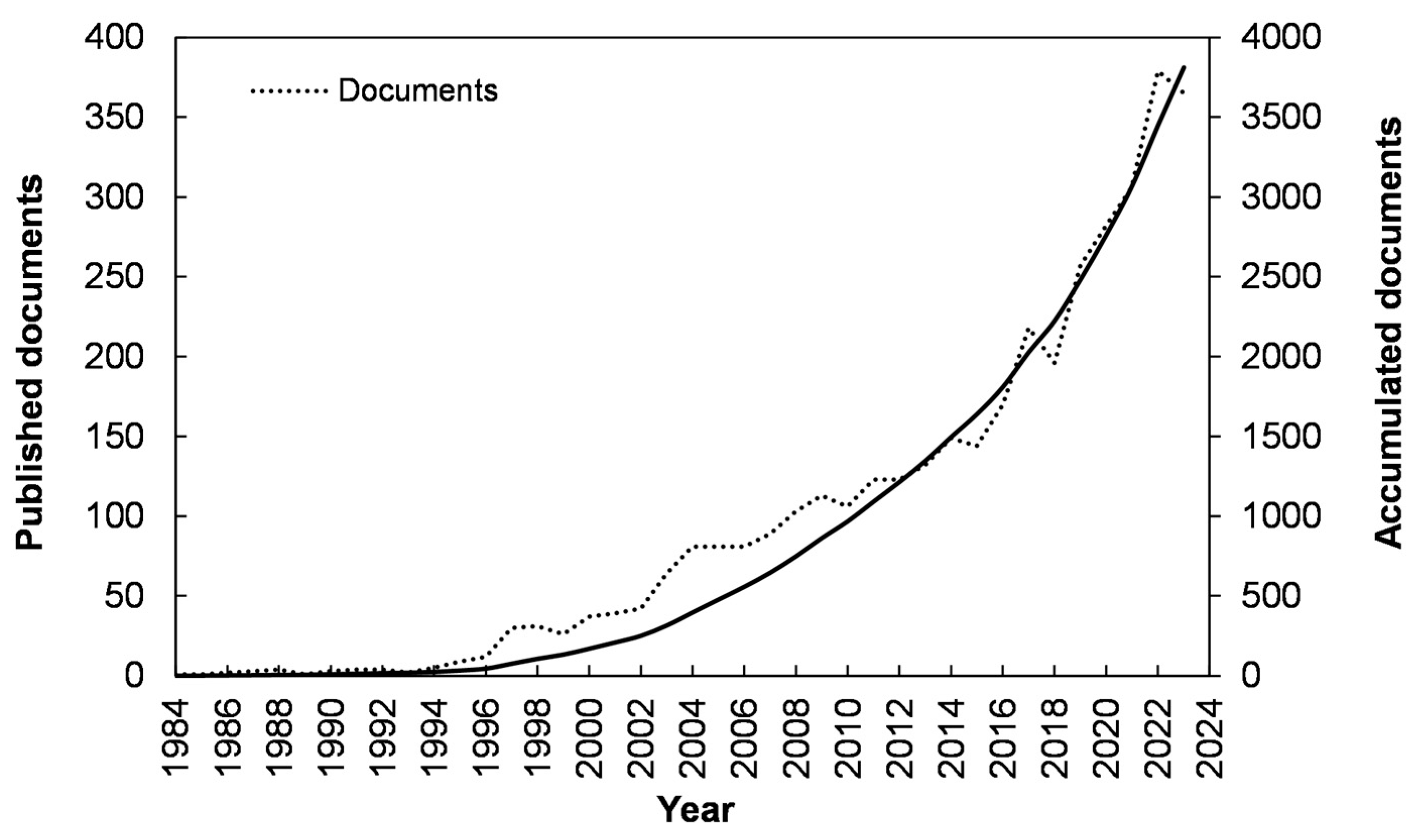

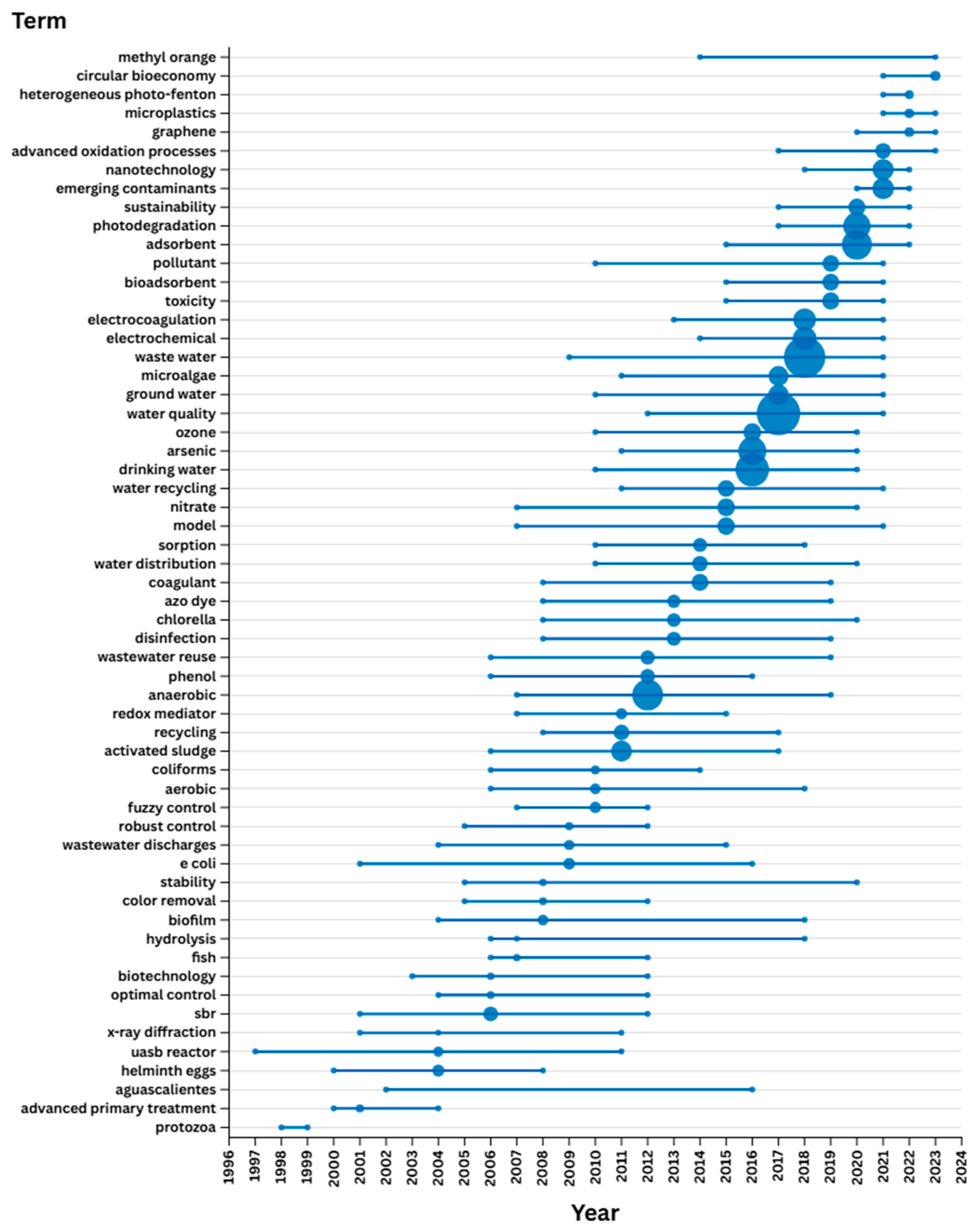
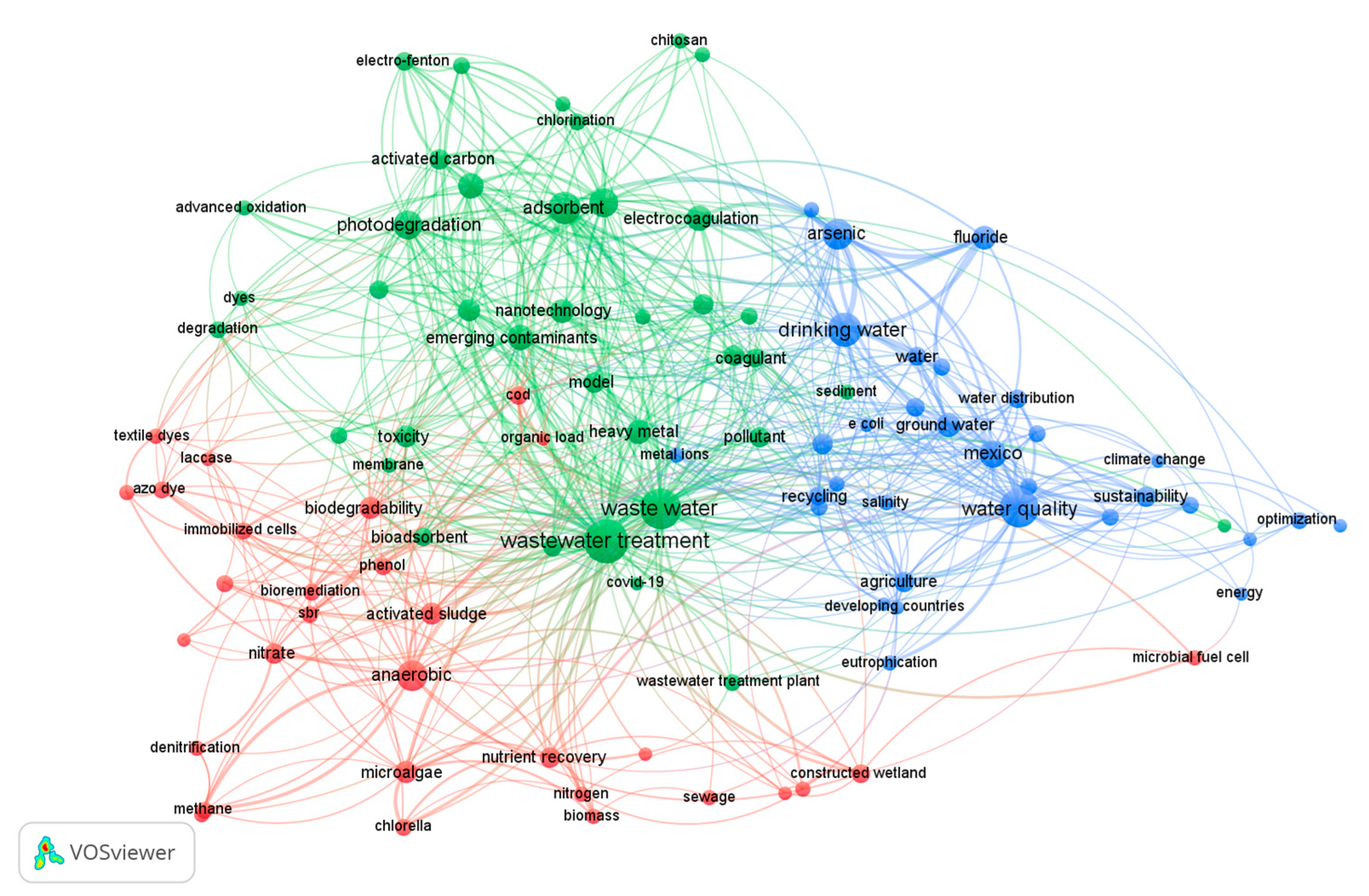
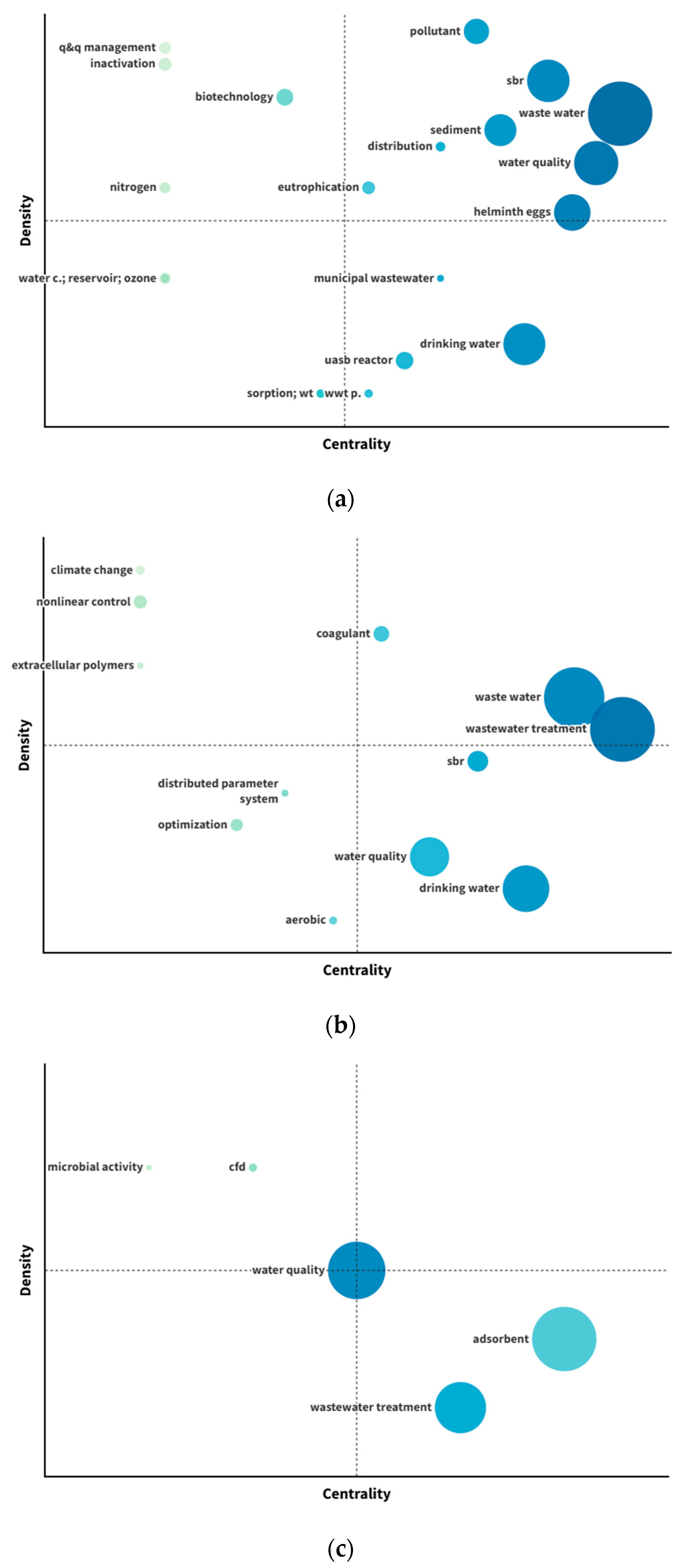
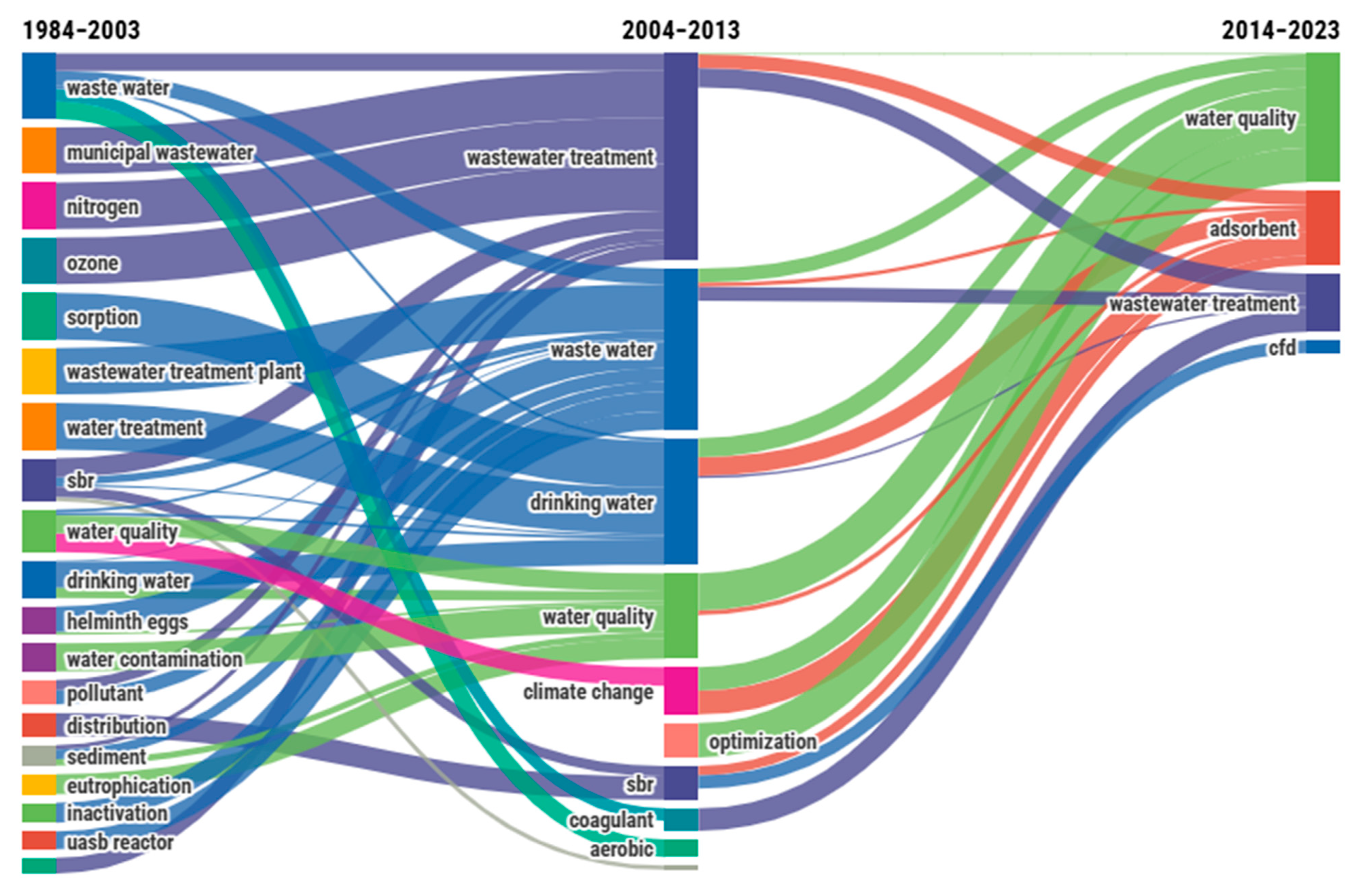

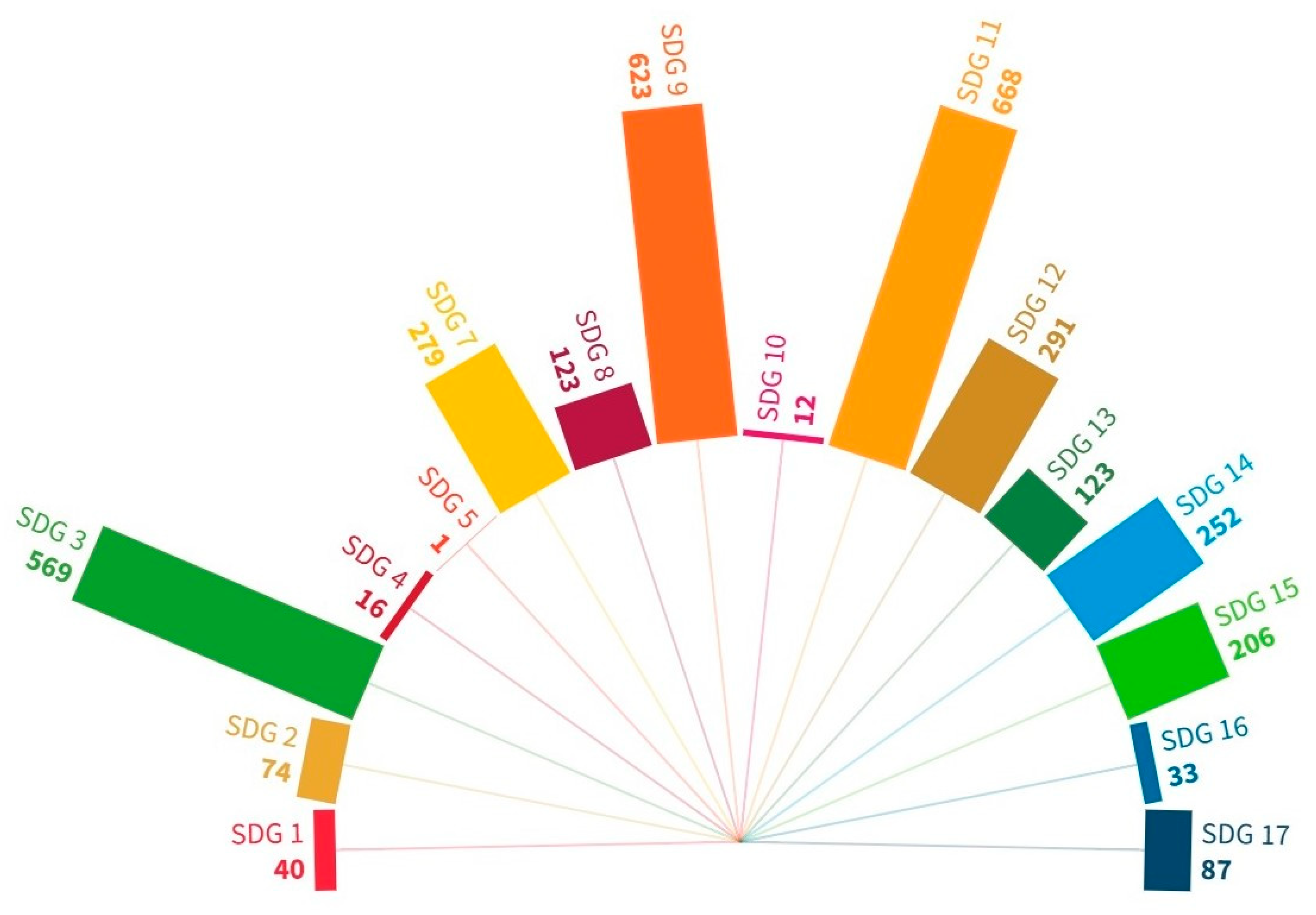
| Target | Description |
|---|---|
| 6.1 | By 2030, achieve universal and equitable access to safe and affordable drinking water for all. |
| 6.2 | By 2030, achieve access to adequate and equitable sanitation and hygiene for all and end open defecation, paying special attention to the needs of women and girls and those in vulnerable situations. |
| 6.3 | By 2030, improve water quality by reducing pollution, eliminating dumping and minimizing release of hazardous chemicals and materials, halving the proportion of untreated waste water and substantially increasing recycling and safe reuse globally. |
| 6.4 | By 2030, substantially increase water-use efficiency across all sectors and ensure sustainable withdrawals and supply of freshwater to address water scarcity and substantially reduce the number of people suffering from water scarcity. |
| 6.5 | By 2030, implement integrated water resources management at all levels, including through transboundary cooperation as appropriate. |
| 6.6 | By 2020, protect and restore water-related ecosystems, including mountains, forests, wetlands, rivers, aquifers and lakes. |
| 6.a | By 2030, expand international cooperation and capacity-building support to developing countries in water- and sanitation-related activities and programs, including water harvesting, desalination, water efficiency, waste water treatment, recycling and reuse technologies. |
| 6.b | Support and strengthen the participation of local communities in improving water and sanitation management. |
| Information | Data |
|---|---|
| Period | 1984 to 2023 |
| Sources | 1040 |
| Documents | 3813 |
| Documents per year | 95.3 |
| Average citations per document | 25.08 |
| References | 167,744 |
| Authors keywords/Index keywords | 9020/19,795 |
| Authors | 11,242 |
| Authors of single-authored documents | 88 |
| Documents per author | 0.34 |
| Authors per document | 2.95 |
| Co-authors per document | 5.14 |
| Collaboration Index | 5.04 |
| Rank | Affiliation | Affiliation ID | Documents |
|---|---|---|---|
| 1 | Universidad Nacional Autónoma de México (UNAM) | 60032442 | 739 |
| 2 | Instituto Politécnico Nacional (IPN) | 60019176 | 346 |
| 3 | Tecnológico de Monterrey (ITESM) | 60007966 | 236 |
| 4 | Universidad Autónoma del Estado de México (UAEMex) | 60002281 | 223 |
| 5 | Centro de Investigación y de Estudios Avanzados del Instituto Politécnico Nacional (CINVESTAV) | 60017323 | 216 |
| 6 | Universidad de Guanajuato (UGTO) | 60033291 | 182 |
| 7 | Instituto Mexicano de Tecnología del Agua (IMTA) | 60017774 | 167 |
| 8 | Universidad Autónoma de San Luis Potosí (UASLP) | 60031335 | 143 |
| 9 | Universidad de Guadalajara (UdeG) | 60008943 | 129 |
| 10 | Universidad Autónoma Metropolitana (UAM)—Unidad Iztapalapa | 60028381 | 121 |
| Rank | Source (ISSN; CiteScore 2023) | ND | H | TC | SYP |
|---|---|---|---|---|---|
| 1 | Water Science and Technology (0273-1223; 4.9) | 202 | 32 | 3898 | 1991 |
| 2 | Chemosphere (0045-6535; 15.8) | 96 | 33 | 4459 | 1999 |
| 3 | Revista Internacional de Contaminación Ambiental (0188-4999; 0.9) | 94 | 11 | 441 | 1996 |
| 4 | Science of the Total Environment (0048-9697; 17.6) | 89 | 41 | 5358 | 2005 |
| 5 | Water (Switzerland) (2073-4441; 5.8) | 88 | 17 | 998 | 2012 |
| 6 | Tecnología y Ciencias del Agua (0187-8336; 0.6) | 75 | 8 | 228 | 2010 |
| 7 | Environmental Science and Pollution Research (0944-1344; 8.7) | 63 | 16 | 836 | 2007 |
| 8 | Water Air and Soil Pollution (0049-6979; 4.5) | 62 | 18 | 939 | 1985 |
| 9 | Journal of Environmental Management (0301-4797; 13.7) | 58 | 23 | 1810 | 2004 |
| 10 | Bioresource Technology (0960-8524; 20.8) | 49 | 34 | 5098 | 1997 |
| 10 | Chemical Engineering Journal (1385-8947; 21.7) | 49 | 28 | 3349 | 2001 |
| 10 | Water Research (0043-1354; 20.8) | 49 | 33 | 6728 | 1992 |
| Rank | Reference | Title | Source | TC | FWCI | Type |
|---|---|---|---|---|---|---|
| 1 | [29] | Heterotrophic cultures of microalgae: Metabolism and potential products | Water Research | 1255 | 9.87 | re |
| 2 | [30] | Recent advances in removing phosphorus from waste water and its future use as fertilizer (1997–2003) | Water Research | 1214 | 9.59 | ar |
| 3 | [31] | Electrocoagulation (EC)—Science and applications | Journal of Hazardous Materials | 1188 | 5.45 | ar |
| 4 | [32] | Review paper on current technologies for decolourisation of textile waste waters: Perspectives for anaerobic biotechnology | Bioresource Technology | 1148 | 6.95 | re |
| 5 | [33] | Pharmaceuticals as emerging contaminants and their removal from water. A review | Chemosphere | 1111 | 7.06 | re |
| 6 | [34] | A review of chemical, electrochemical and biological methods for aqueous Cr(VI) reduction | Journal of Hazardous Materials | 1094 | 5.59 | re |
| 7 | [35] | Fundamentals, present and future perspectives of electrocoagulation | Journal of Hazardous Materials | 1038 | 6.00 | ar |
| 8 | [36] | Production of bioenergy and biochemicals from industrial and agricultural waste water | Trends in Biotechnology | 848 | 5.78 | re |
| 9 | [37] | Cr(VI) and Cr(III) removal from aqueous solution by raw and modified lignocellulosic materials: A review | Journal of Hazardous Materials | 810 | 4.29 | re |
| 10 | [38] | Molecular mechanisms of fluoride toxicity | Chemico-Biological Interactions | 792 | 3.99 | re |
Disclaimer/Publisher’s Note: The statements, opinions and data contained in all publications are solely those of the individual author(s) and contributor(s) and not of MDPI and/or the editor(s). MDPI and/or the editor(s) disclaim responsibility for any injury to people or property resulting from any ideas, methods, instructions or products referred to in the content. |
© 2025 by the authors. Licensee MDPI, Basel, Switzerland. This article is an open access article distributed under the terms and conditions of the Creative Commons Attribution (CC BY) license (https://creativecommons.org/licenses/by/4.0/).
Share and Cite
Reynoso-Cuevas, L.; Robledo-Peralta, A.; Ortega-Avila, N.; Rodríguez-Muñoz, N.A. Water and Waste Water Treatment Research in Mexico and Its Occurrence in Relation to Sustainable Development Goal 6. Earth 2025, 6, 114. https://doi.org/10.3390/earth6040114
Reynoso-Cuevas L, Robledo-Peralta A, Ortega-Avila N, Rodríguez-Muñoz NA. Water and Waste Water Treatment Research in Mexico and Its Occurrence in Relation to Sustainable Development Goal 6. Earth. 2025; 6(4):114. https://doi.org/10.3390/earth6040114
Chicago/Turabian StyleReynoso-Cuevas, Liliana, Adriana Robledo-Peralta, Naghelli Ortega-Avila, and Norma A. Rodríguez-Muñoz. 2025. "Water and Waste Water Treatment Research in Mexico and Its Occurrence in Relation to Sustainable Development Goal 6" Earth 6, no. 4: 114. https://doi.org/10.3390/earth6040114
APA StyleReynoso-Cuevas, L., Robledo-Peralta, A., Ortega-Avila, N., & Rodríguez-Muñoz, N. A. (2025). Water and Waste Water Treatment Research in Mexico and Its Occurrence in Relation to Sustainable Development Goal 6. Earth, 6(4), 114. https://doi.org/10.3390/earth6040114






